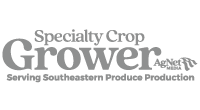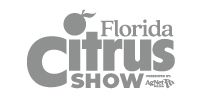Individual protective covers (IPCs), used primarily to protect young citrus trees from HLB-spreading Asian citrus psyllids, have become ubiquitous in Florida citrus groves in recent years. New University of Florida Institute of Food and Agricultural Sciences (UF/IFAS) research shows the trees grown under the IPCs also grow well for a few years after growers remove the bags. Growers typically remove …
All In For Citrus Podcast, August 2024
The August episode of the All In For Citrus podcast features highlights from this year’s Citrus & Specialty Crop Expo. The event included two citrus educational sessions that covered a wide range of topics, including HLB management, other pest management topics and new varieties. Michael Rogers, director of the University of Florida Institute of Food and Agricultural Sciences (UF/IFAS) Citrus …
Sneak Peek: September 2024 Citrus Industry
HLB has drastically changed how citrus is grown in Florida. The September issue of Citrus Industry magazine offers insight on some of the newer production practices growers are using to manage the disease. In a feature story, Citrus Industry Editor-in-Chief Frank Giles looks at how citrus nutrient management recommendations are continuing to evolve in the HLB era. In the article, …
Getting a Handle on the Giant Swallowtail
By Amir Rezazadeh The giant swallowtail butterfly (Papilio cresphontes) is a beautiful insect, admired for its large wingspan and vibrant yellow and black coloration. However, for citrus growers, this butterfly is often viewed with less enthusiasm. The larvae of the giant swallowtail, commonly referred to as “orange dogs,” can cause significant damage to citrus trees. Understanding the nature of this …
Talking Trunk Injection at Citrus & Specialty Crop Expo
The educational program on the first day of the Citrus & Specialty Crop Expo focused on trunk injection of oxytetracycline (OTC) being applied to citrus to treat HLB. Trees have received their second OTC treatment, and growers are hopeful trees will respond with better fruit retention and improved quality. Ute Albrecht, University of Florida Institute of Food and Agricultural Sciences …
PGRs Promote Tree Health
The use of plant growth regulators (PGRs) has been a popular method to treat HLB-infected citrus trees. The materials have continued to be applied in conjunction with trunk injection of oxytetracycline (OTC) to improve tree health. Tripti Vashisth, an associate professor of horticultural sciences with the University of Florida Institute of Food and Agricultural Sciences (UF/IFAS), has been studying PGRs …
Insights on Soil Amendments, Soil pH and Nutrient Availability
By Davie Kadyampakeni, Tripti Vashisth and Duplicate Sambani The University of Florida Institute of Food and Agricultural Sciences (UF/IFAS) conducted an experiment for four and a half years to determine effects of soil amendments on soil pH. The impacts of fulvic acid, humic acid and sulfuric acid with and without elemental sulfur were compared. Canopy size, fruit yield, fruit quality, …
All In For Citrus Podcast Holds a Wealth of Information
There is a constant stream of research flowing out of the University of Florida Institute of Food and Agricultural Sciences (UF/IFAS). In recent years, much of that science has focused on the fight against HLB. There are various venues where growers and other stakeholders can learn more about this research, including the All In For Citrus podcast. The podcast, produced …
Sustaining Citrus Production in the HLB Era
The virtues of daily irrigation and increased micronutrient applications were among key points researcher Davie Kadyampakeni made in an Aug. 13 discussion of citrus production in the HLB era. Kadyampakeni is a University of Florida Institute of Food and Agricultural Sciences (UF/IFAS) associate professor of soil, water and ecosystem sciences at the Citrus Research and Education Center in Lake Alfred. …
CITRUS NURSERY SOURCE: What’s on Tap for 2024–25
By Peter Chaires The New Varieties Development and Management Corp. (NVDMC) has awarded funding to citrus projects for the 2024–25 season. Exciting things are happening in crop transformation, but significant progress is also being made in conventional breeding. The NVDMC board continues to support conventional breeding projects, each with a focus on near-term results, while still setting a foundation for …
New HLB Publication at the Citrus & Specialty Crop Expo
By Michael E. Rogers Do you plan to attend the Citrus & Specialty Crop Expo on Aug. 21–22 at the Florida State Fairgrounds in Tampa? If so, you’ll want to stop by the University of Florida Institute of Food and Agricultural Sciences (UF/IFAS) Citrus Extension booth to pick up the latest publication on HLB management assembled by UF/IFAS citrus experts. …
Symposium Unites Growers and Ag Industry Professionals
The second annual Growing Together Symposium was hosted at the University of Florida Institute of Food and Agricultural Sciences (UF/IFAS) Mid-Florida Research and Education Center in early August. The event was a forum for growers and agricultural industry professionals to learn about various business-related topics. Center director Kirsten Pelz-Stelinski welcomed attendees and noted the Apopka, Florida, facility is continuing its …
Survey Asks Growers About Oxytetracycline Trunk Injection
University of Florida Institute of Food and Agricultural Sciences (UF/IFAS) researchers are conducting a grower survey about the use of oxytetracycline (OTC) trunk injection in citrus production. The researchers want to learn about the adoption, efficacy and economic feasibility of OTC injections. The survey, which can be accessed here, will take approximately 15 minutes to complete. It should be completed …
Visit the UF/IFAS Citrus Extension Booth at the Citrus & Specialty Crop Expo
By Jamie D. Burrow and Michaela Ivy Since the spring, planning has been underway for the University of Florida Institute of Food and Agricultural Sciences (UF/IFAS) citrus Extension team booth to be on display at the Citrus & Specialty Crop Expo. The event is Aug. 21–22 at the Florida State Fairgrounds in Tampa. The booth will be in the same …
CUPS Allows Profitable HLB-Free Citrus Production
The U.S. Department of Agriculture National Institute of Food and Agriculture (USDA/NIFA) has invested more than $250 million to find a solution for HLB. One example of USDA NIFA-funded research is citrus under protective screen (CUPS). University of Florida Institute of Food and Agricultural Sciences (UF/IFAS) scientist Arnold Schumann and colleagues began testing CUPS at the Citrus Research and Education Center …
Preview of the Citrus & Specialty Crop Expo Seminars
In the July All In For Citrus podcast, Tripti Vashisth, associate professor of horticultural sciences with the University of Florida Institute of Food and Agricultural Sciences (UF/IFAS), gave a sneak peek of the citrus educational seminars at the upcoming Citrus & Specialty Crop Expo. The event takes place on Aug. 21–22 at the Florida State Fairgrounds in Tampa. Vashisth coordinated …
Management of the Invasive Peanut Snail in Citrus
Two University of Florida Institute of Food and Agricultural Sciences (UF/IFAS) researchers and an Extension agent authored an article in the Cold Hardy Citrus Connection about the invasive peanut snail in citrus. The authors are Xavier Martini, associate professor of entomology; Issac Esquivel, assistant professor of entomology; and Extension agent Danielle Williams. Excerpts follow. Bulimulus bonariensis (also known as Bulimulus …
Satsuma Pruning and Thinning Trials
University of Georgia (UGA) Extension agents Jake Price and Sydni Ingram recently shared information about UGA satsuma pruning and thinning trials. An edited version of their Cold Hardy Citrus Connection article follows: The percentage of cull fruit in satsumas is very high due to the fruit being too soft, too green or too big. Satsumas are very cold hardy, delicious, …
Using Herbicides in Hot Weather
By Ramdas Kanissery Managing weeds during the summer is crucial for Florida citrus. However, due to the high temperatures typical of Florida’s summer months, several factors must be considered when using herbicides in citrus groves during hot weather. INCREASE EFFECTIVENESS High heat and drought stress can slow plant growth and affect how herbicides move or translocate in weeds. When temperatures …
Sneak Peek: August 2024 Citrus Industry
Despite low production levels this season in Florida, grower success stories can still be seen in citrus. Wm. G. Roe & Sons is a prime example. The August issue of Citrus Industry magazine tells how the century-old citrus business is still flourishing. As the next generation of leadership steps up in the Roe family, the business is also implementing a …





























